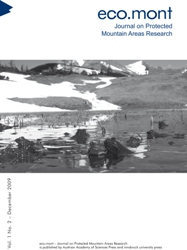Marion Leng,
Stefano Martellos
S. 57 - 60
doi:
10.1553/ecomont2s57
Verlag der Österreichischen Akademie der Wissenschaften
doi:
10.1553/ecomont2s57
Abstract:
Switzerland has 89 moorland landscapes of particular beauty and of national significance. They consist of a large number of natural, near-natural and human-made elements, which entirely determine the character of each individual moorland landscape. They are generally perceived as valuable in terms of ecology, history and aesthetics: they provide habitats for endangered species and for human beings, they bear witness to traditional extensive forms of land use, and they are seen as aesthetically valuable for leisure and recreation. Moorland landscapes are the only constitutionally protected landscape type in Switzerland, but, in spite of the widely accepted aim to protect them, they are by no means secure. Conflicting trends, such as the intensification of land use, the abandonment of agricultural land and the growth in outdoor sports, mean that the biodiversity, unique character and variety of some of the remaining moorland landscapes are threatened. They can only be preserved if extensive land use, adapted to the special conditions in moorland landscapes, and associated maintenance measures continue and unsuitable forms of land use and over-use are avoided.
2009/11/26 12:52:03
Object Identifier:
0xc1aa5576 0x0022aa0f
Rights:https://creativecommons.org/licenses/by-nc-nd/4.0/
The journal “eco.mont” – Journal of protected mountain areas research and management – was published for the first time in June 2009.
The journal was founded as a joint initiative of the Alpine Network of Protected Areas (ALPARC), the International Scientific Committee on Research in the Alps (ISCAR), the Austrian Academy of Sciences (ÖAW) and the University of Innsbruck.
The journal aims to highlight research on and management issues in protected areas in the Alps without excluding other protected mountain areas in Europe or overseas. Its target audiences are scientists from all related disciplines, managers of protected areas and interested individuals including practitioners, visitors, teachers, etc.
The journal presents peer-reviewed articles in English by authors who research protected mountain areas and management issues within these areas. It's published twice a year as a collaboration of the Austrian Academy of Sciences Press – responsible for the e-version – and Innsbruck University Press – responsible for the print version.
Die Zeitschrift „eco.mont“ – Zeitschrift zur Forschung in Gebirgsschutzgebieten – erschien im Juni 2009 zum ersten Mal. Die Zeitschrift wurde auf Initiative des Netzwerks Alpiner Schutzgebiete (ALPARC), der Schweizer Akademie der Naturwissenschaften (ISCAR), der Österreichischen Akademie für Wissenschaft (ÖAW) und der Universität Innsbruck gegründet. Sie hat das Ziel, Themen zu behandeln, die gleichzeitig Forschung und Verwaltung in und über die Schutzgebiete der Alpen betreffen, ohne dabei andere Gebirgsschutzgebiete Europas oder anderswo auszuschließen. Diese neue Zeitschrift richtet sich an ein Publikum von Wissenschaftlern der verschiedensten Fachbereiche, an die Verwalter von Schutzgebieten und an alle sonstigen Interessierten, Praktiker, Besucher, Lehrpersonal etc. einbegriffen. Die Zeitschrift veröffentlicht begutachtete Beiträge auf Englisch von Autoren, die Fragen der Gebirgsschutzgebieten und deren Verwaltung forschen. Sie erscheint zweimal pro Jahr, auf der Basis der gemeinsamen Anstrengungen des Verlags der Österreichischen Akademie der Wissenschaften, der für die digitale Fassung verantwortlich ist, und der Presse der Universität Innsbruck, verantwortlich für die gedruckte Fassung.



 Home
Home
 Print
Print
 References
References
 Share
Share

